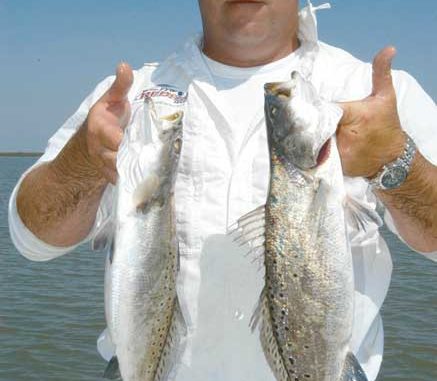
Summer fishing for speckled trout is great at sprawling Bulls Bay.
Rob Beglin drives all the way from Pawley’s Island, towing his boat past miles and miles of great-looking water.Tom Siwarski drives all the way from Charleston, towing his boat past miles and miles of great-looking water.
They each drive close to an hour, one way, to fish for speckled trout in Bulls Bay, and one of the big reasons is that almost nobody else makes the drive.
Oh, and the fishing happens to be fantastic — especially during the summer, when the waters closer to their homes are filled with pleasure boaters of all kind, and lots of them.
Nothing like showing up at the boat ramp in the morning and only finding a dozen empty trailers in the lot — on a Saturday.
Oh, did we mention how good the fishing is?
“Last fall was the best trout fishing we’ve ever had; 75 fish a day was possible,” said Beglin, a building contractor who fishes the IFA and FLW redfish tours but is a closet trout maniac. “The fishing is really, really good at Bulls Bay. All year-round, you can catch trout, and the trout are better than the redfish, especially during the summer. We catch a lot of big trout in June and July. You’ll catch some schoolies, but in July, you’ll get some of your monster trout, spawners that are just getting ready to go.”
Siwarski, a fishing guide who operates Carolina Aero Marine Adventures, said the action might be great around Charleston, but he starts making the drive to Bulls Bay when the weather warms up and his home waterways get clogged up — and he makes it for a solid six months, because the fishing is so good an hour up Rt. 17.
“The trout fishing is really, really good. It turns on in mid-May and stays good all the way through November,” Siwarski said. “This place is full of trout; that’s why I trailer from Charleston all the way up here. An average day during the summer is 25 to 35 trout, most of them 17 to 18 inches long, but some bigger.
“I fish Charleston a lot in the winter and spring, but when it warms up and the water gets crowded, I prefer to go to Bulls Bay. There won’t be many boats, and the ones you see will all be fishermen; you won’t see anybody pulling a tube — and no jet skis.”
Fishermen will normally travel miles and miles for great fishing, even leaving good fishing at their doorstep. But Bulls Bay is a different animal. It’s a sprawling mixture of open water and marsh, creeks and cuts and islands and tidal ponds.
But it’s mostly all shallow water, very shallow, with beds of oyster rocks just waiting to grab the lower unit of an unsuspecting outboard motor.
“A lot of people are scared to come down here because it is shallow. Nobody wants to come this far to fish. The Charleston people stay there, and the Georgetown people stay at Winyah Bay,” said Beglin. “But I know this area so well. There’s no fishing pressure, and the fishing is great.”
Well, it’s great for people like Beglin and Siwarski, but what about the Average Joe? The two fishermen agree the kinds of places you fish at Bulls Bay, and the kind of tactics you use, are no different from the things you would do and places you’d go in the Wando River, behind Sullivans Island near Charleston or in Winyah Bay or North Inlet on the southern end of the Grand Strand.
You just have to be careful getting from Place A to Place B.
“The best thing to do is go out at low tide and look around,” Siwarski said. “That way, you can see everything you’ll need to see, and if you do get stuck, you know the tide will be coming in to float you off. That’s what I did to start with, and that’s what I’d do again.”
Once you put in — and the ramp at the Buck Hall Recreation Area in the Francis Marion National Forest a few miles south of McClellanville is the only public ramp in the area — and figure out where you can pilot your boat, it’s a matter of standard tactics for speckled trout.
“You’ve got to fish a lot of oyster shells and grass, and you’ve got to have clear water,” said Beglin, who fishes redfish tour events with partner Eric Gobbett of Georgetown as the Coastal Energy Fishing Team. “Trout don’t like to bite in dirty water. And you need to find some good rip and eddies, places where you’ve got moving water.
“You look for clear water, moving water, and you’ve got to have (oyster) shells. You find a place that’s got all three, and that’s where they live. The bays are all about the same; you fish the same structure from one place to another. The average depth of a lot of the bay at low tide is about a foot or two.
“You’re not looking more than seven or eight feet deep, and you’re looking around obvious structure: shells off flats, places where fish will go where they can catch bait coming off the flats.
“In the winter, the trout stay back in deeper water in the creeks, but they start to move out in April and May. In June, July and August, they’re back in deeper water, four or five feet deep. There are some creeks that are 10 to 12 feet deep, but you don’t need to fish that deep.”
Siwarski concentrates on marsh banks around points, textbook places where fish can quickly move up out of deeper water to feed. Oyster rocks are a key ingredient.
“Oysters seem to be the key, along with moving water, and water that’s as clear as you can find in Bulls Bay,” he said. “The water will get dirty on a northeast or east wind, and a big, flood tide will dirty it up.
Beglin said it will take the bay about two days to clear up after a big, dirty-water event. “We can sustain a 20- to 25-mph wind out of the southwest, and it will stay pretty clean,” he said. “But a northeast messes up the bay; it stands it on its head. South and west winds are when the fishing is bets; east winds get it dirty.”
Siwarski said one factor that really makes summertime trout fishing good at Bulls Bay is “They gang up pretty good.
“It’s rare to catch just one here or there. When you get bit in a spot, you can catch 10 or 15 fish in the same 50-yard stretch of bank,” he said. “And it seems like, when I find a spot they’re using, they’ll stay there. We were still catching fish last December in the places we were catching them during the summer.”
Beglin agrees that a fisherman can get rich on one spot if he’s careful.
“In the summer, if you catch one, you stop and fish that area a lot more. There will always be more fish there,” he said. “If I’m fishing along toward a point and catch a fish, I’ll fish to the point, then turn around and fish back down that bank. Most of the time, you’ll be able to pick up several more fish.”
Both Siwarski and Beglin concentrate on a 4- to 6-hour window each day. They like to fish the last two or three hours on the rising tide, when the water is at its highest and up in the marsh grass, and the first two or three hours after the tide has crested.
The reason?
Trout won’t be feeding in six inches of water like redfish; they need a couple of feet to be comfortable. Beglin said spots that are productive for redfish on low water are usually productive for trout on higher water, when several feet of water are covering the same oyster rakes that are exposed on the low end of the tide.
“You’ll do the best two hours before high tide and two hours after,” he said. “You get good, high water, and they move up out of the deeper water and feed up. You can catch a few on low water, occasionally, but nowhere near as many fish when the water is up.”
Neither Siwarski or Beglin fish any kind of live bait on a regular basis; they are tried-and-true believers in artificials. Both fishermen will use topwater baits early in the morning, but once the sun gets up, they switch to a single, basic rig. Siwarski likes to fish a DOA shrimp under a Bayside Paradise Popper cork, and Beglin likes to fish a Saltwater Assassin shad body on an eighth-ounce jig.
“For topwaters, a high tide in (mid-morning) is best,” Beglin said. “If you can catch it two hours before high tide first thing in the morning, that’s really the best time to fish a topwater. You can work a topwater and really get on ‘em, especially on windy days.”
Beglin will fish a Super Spook Jr. in bone or bone/red head. If he thinks specks are in the area but are shying away from hitting a topwater bait, he’ll move to a sinking MirrOLure — a 52MR18, TTR08 and MR808. He fishes them like a freshwater jerkbait, letting them sink a few inches and jerking them along with his rod tip.
“A lot of people won’t throw a MirrOLure, but we’ve noticed that we catch consistently bigger fish on them,” Beglin said. “You can throw one to see if the trout are feeding on mullet or pogies.”
Siwarski has caught specks on topwater baits as late as 10 or 10:30 a.m., on sunny days, but he says the bite is usually over by 8 to 8:30. Trout will hit a Spook or TopDawg (Siwarski likes the black/silver color combination) even later in the day on an overcast day, and he believes his best quality fish will consistently come on the topwaters.
Once he figures the topwater bite is over, Siwarski goes to the popping cork and imitation shrimp. It’s the perfect bait for his parties, especially the ones who may not be accomplished fishermen.
Siwarski fishes the rig on a medium to medium-light action Shimano spinning combo. The reel is spooled with 10-pound Power Pro braid, and below the cork, he ties on an 18- to 24-inch leader of 15-pound fluorocarbon. A DOA shrimp — he’s not particular about colors — completes the outfit.
“The cork is the big thing,” Siwarski said. “I’ll cast it out, pop it one time, then give it five or 10 seconds and pop it again. I like to throw it upcurrent, or if the current is running left to right, I’ll throw it to the left and just let it swing back with the current. I don’t like to fish it against the current. Bait won’t swim against the current, and trout obviously sit there, facing the current, waiting for the bait to be swept along with it. And we’ve got everything here: shrimp, finger mullet and menhaden.”
Beglin has fished soft-plastic grubs of all kinds and shapes on jigheads. It wasn’t until four or five years ago, he said, that an older, veteran fisherman told him he’d catch more trout if he switched to a shad-body lure than anything else. Also known as “swim baits,” the little chunks of plastic have a stump or “kicker” tail that produces a great deal of vibration when it’s retrieved.
Beglin fishes the Saltwater Assassin version in three colors: tiger special, electric chicken or Cajun croaker. When they’re fishing together, he and Gobbett will rig up with different colors and fish until they discover which one trout are tuned into that particular day.
“I fish it on an eighth-ounce jighead, and you’d better take a lot of them with you; I usually break off about 20 a day (on the oysters),” Beglin said. “I used to fish a quarter-ounce jighead, but I was breaking off almost every cast. The eighth-ounce one gives the bait more natural action, and it doesn’t sink as fast and get in the oysters.”
Beglin fishes a medium-light, 7-foot Fenwick spinning rod and a Shimano reel spooled with 12-pound P-Line copolymer, a line that has very little stretch.
“I’ve never really used a (shock) leader, because I’ve never really had any big trout cut me off,” said Beglin, who makes a long cast, lets his bait fall a foot or so, then starts working it back to the boat in short jerks and winds.”

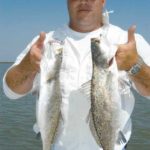
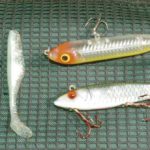
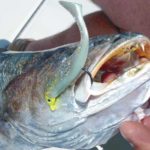
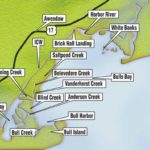
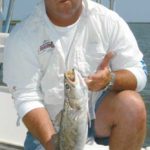



Be the first to comment